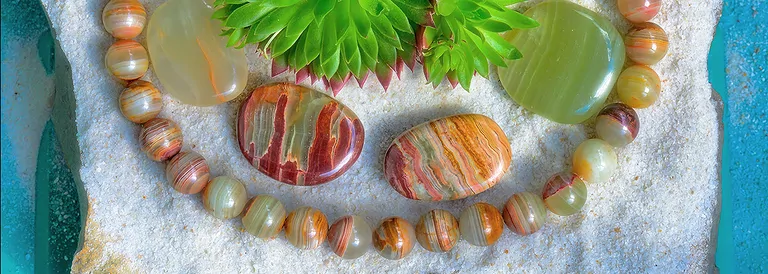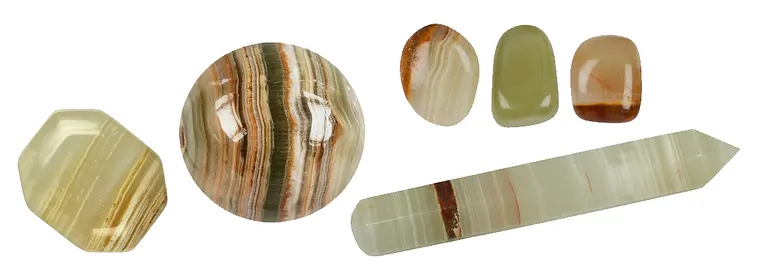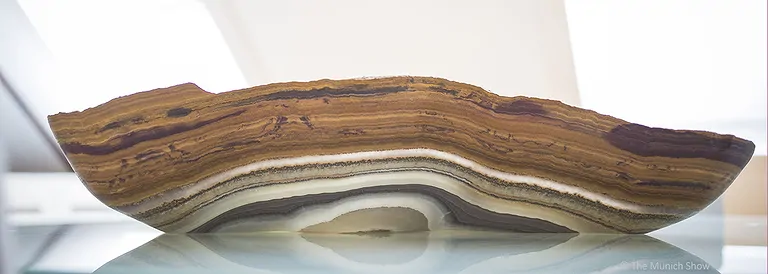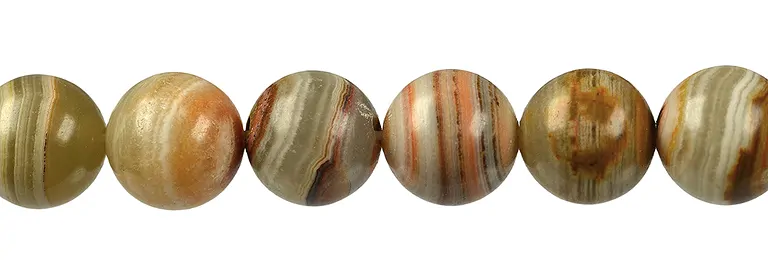
Onyx Marble - Meaning, effect and application
Onyx Marble is a good companion in somewhat hectic, effervescent time. The mineral helps to achieve the necessary balance between tension and relief, activity and reste. A good Rhythm between these two extremes can be found and maintained with the support of the mineral, so that also the flexibility does not fall by the wayside. Onyx Marble brings activity and calmness into a balanced alternation. Just as the colored bands of the mineral alternate, so should phases full of energy and projects alternate with relaxed times.
Usage of onyx marmor in genstone healing
The alternation of load and relief is also important, if plans and projects (again) to a good rhythmic development are to be brought. If it goes too fast and too hectically ahead, everything is to happen at the same time and as quickly as possible, the aragonite portion provides the necessary calm and serenity. If a little push is necessary to really get going, to overcome inertia and to tackle the necessary things full of self-confidence, the calcite part supports. Together, sustainable processes are accelerated
In stone medicine, onyx marble is also often used when a stone is required, which makes more loosened and free. By the alternation of activity and rest the ability to adapt is strengthened, to requirements can be more flexible to be reacted.
This is used, for example, in reflexology massage with gemstone styluses: As a massage stone with neutral energy quality, the stone is simultaneously restorative and relaxing and thus has an overall relieving effect on long-lasting stress.
Tumbled stones, massage stones, spheres and more onyx marble items at wholesale prices

Onyx marble, aragonite calite - mineralogical facts
Onyx marble belongs to the comparatively small mineral group of carbonates or limestones. Within this group, onyx marble is a representative of the calcareous sinters, also called spring limestones or freshwater limestones. In it all the Minerals are summarized, which develop secondarily mostly at warm sources (temperatures over 29° C), if precipitations are caused by carbon dioxide loss in the form of finest lime particles (so-called bubbling stones). Also at underground freshwater streams in karst areas, calcareous sinter or onyx marble can be formed; better known are the "calcareous cones" in caves, the dripstones. These are non-marine, chemical sediments that differ mainly in porosity and the proportion of the minerals Calcite and Aragonite.
While other limestones, such as calcareous tuff or travertine, contain calcite or aragonite and are usually porous, Onyx Marble is rather compact, has hardly any pores, and consists of both calcite and aragonite. Both minerals are chemically identical (CaCO3), but have a different crystal structure: calcite is trigonal, aragonite rhombic. Therefore, according to the international nomenclature, Onyx Marble is mineralogically correctly called Calcite-Aragonite or Aragonite-Calcite, Onyx Marble (Aragonite Calcite) is its common trade name. Other names in common use in retail as well as wholesale trade are calconyx, calcite-alabaster, ribbon marble, aragonite marble, chalcedony onyx or marble onyx.
Tumbled stones, massage stones, spheres and more onyx marble items at wholesale prices
Onyx marble - colours and banding
As minerals, iron and magnesium may be admixed. Typical is the always present banding as a sign of an alternating deposition of calcite and aragonite; perpendicular to the plane of sedimentation one can see usually the long, slender and tapering aragonite crystals can be recognized. Onyx marble often shows up in the colors white, yellow, orange, red, green, and brown, as well as all gradations in between. Particularly beautifully and gladly the stones of places of discovery, which result in a multicolored picture by changing mineral inclusions. Also a spectacular effect have through a differentiated play of colors bizarre-looking bulbous or coral-like structures in the level of the sedimentation. In the trade are mostly stones with cream-colored and olive-green color to find, since these are most often sin

Origin of the name onyx marble
The name Onyx marble is misleading, since with the two parts of the name "Onyx" and "Marble" completely different stones are designated. In the stonemasonry trade, according to old tradition, all banded stones are called "Onyx" and polishable limestones have been called "Marble" since ancient times. However, in mineralogy, Onyx is a term for a mostly black chalcedony and Marble is a term for a metamorphic limestone. "Onyx marble" thus has has nothing to do with the mineralogical terms Onyx or Marble. Nevertheless, this term has naturalized with the grinders, the dealers and also in the arts and crafts.
Formation and localities of onyx marble
Most stones are mostly formed in thin banks of a few decimeters; therefore, only smaller products can be cut from the material. Large bench thicknesses, on the other hand, show only a few deposits. In addition a mixture of travertine and calcareous sinter often occurs, which makes the stone visually less attractive and makes processing more difficult due to a natural mechanical instability. As a result, a lot of raw material has to be sorted out or before grinding the stone must be consolidated with synthetic resin, which thus has a great influence on the (high) price.
Important deposits are found in Pakistan, Mexico, USA, Egypt, Algeria, Argentina, Brazil, Iran, Turkey and Italy, distributed over all ages of the earth. Polished items such as massage stones, drilled stone pieces and chain strands in our offer are cut from Pakistani raw material. The rough for bowls, vases and other items for room decoration in creamy beige tones that we carry in our wholesale assortment comes from Mexico.
In cultural history onyx marble was already used in ancient times for the manufacture of vessels, vases and sculptures. A similar use is also known from the Aztec culture. In the cathedral of Orvieto is Onyx marble as a church window can be seen. However, due to its structure and banding, the mineral is still popular today. Mostly the objects are translucent in the light and thus achieve an interesting, very attractive effect. Nowadays, onyx marble is mainly known as souvenirs from North African countries.

Tumbled stones, massage stones, spheres and more onyx marble items at wholesale prices
Mineralogical profile of onyx marble
Chemical formula, mineral class: CaCO3, carbonate; about 80% aragonite, 20% calcite
Formation: sedimentary by rhythmic deposition in warm springs or as dripstones in caves
Color: greenish, orange, red, yellow, white and brown banded and all gradations in between
Gloss: Fat to silky gloss
Crystal system: rhombic (aragonite), trigonal (calcite)
Moh hardness: 3 to 4
Splitability, fracture: poor splitability, conchoidal fracture
Formation, main supplying countries: Pakistan, Mexico
Appearance: dense, but transparent masses of different colored, parallel layers. The banding is often curved and of varying intensity
Use: Onyx marble is the trade name of this limestone, which is used mainly for decorative art objects.
Onyx Marble is used to help Aries, Sagittarius and Aquarius-born people find the right measure.
Tumbled stones, massage stones, spheres and more onyx marble items at wholesale prices